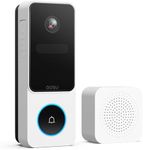Buying Guide for the Best Video Doorbell For Google Home
Choosing a video doorbell that works well with Google Home can make your home smarter and more secure. The right video doorbell lets you see and talk to visitors from your phone or smart display, get alerts when someone is at your door, and even integrate with other smart devices. To find the best fit, you should focus on compatibility, video quality, connectivity, power options, and extra features that match your needs and lifestyle.Google Home CompatibilityThis spec tells you whether the video doorbell can connect and work smoothly with Google Home devices, such as Nest Hubs or Google Assistant speakers. It's important because not all video doorbells are designed to integrate with Google Home, and you want to be able to see who's at your door or get notifications through your preferred smart home system. Some doorbells offer basic compatibility, like sending alerts, while others allow live video streaming on your Google display. If you want full integration, look for models that specifically mention Google Home or Google Assistant support. Your choice should depend on how much you want to control or view your doorbell through Google devices.
Video ResolutionVideo resolution refers to the clarity and detail of the video captured by the doorbell camera. Higher resolution means a clearer image, which helps you recognize faces and details at your door. Common resolutions include 720p (HD), 1080p (Full HD), and 2K or higher. 720p is basic and may be enough for simple monitoring, 1080p offers a good balance of clarity and data usage, while 2K or higher provides very sharp images but may require more internet bandwidth. If you want to clearly see faces or read small details, go for higher resolution, but if your internet connection is slower, a lower resolution may be more reliable.
Field of ViewField of view describes how wide an area the camera can see. It's measured in degrees, with wider angles capturing more of your doorstep and surroundings. Typical ranges are from about 120° to 180°. A narrow field of view might only show the person at your door, while a wide field of view can show packages on the ground or people approaching from the side. If you have a wide porch or want to monitor more than just the immediate doorway, choose a wider field of view. For small entryways, a narrower angle may be enough.
Power SourceVideo doorbells can be powered by batteries, hardwired to your existing doorbell wiring, or sometimes both. Battery-powered models are easier to install and can go anywhere, but need to be recharged every few months. Hardwired models use your home's electricity, so you don't have to worry about charging, but installation can be more involved. If you want a simple setup or can't access wiring, battery power is best. If you prefer a set-it-and-forget-it solution and have existing wiring, hardwired is more convenient.
Two-Way AudioTwo-way audio lets you talk to visitors through the doorbell using your phone or smart display. This is important for communicating with delivery people, guests, or even deterring unwanted visitors. Most video doorbells offer this feature, but the quality can vary. Some have noise cancellation for clearer sound. If you expect to use this feature often, look for models with good audio reviews or enhanced audio features.
Motion Detection and AlertsMotion detection allows the doorbell to alert you when someone approaches your door, even if they don't ring the bell. Some models offer basic motion alerts, while others have advanced features like customizable motion zones or person detection to reduce false alarms. If you live on a busy street, advanced motion settings can help you avoid constant notifications. If you want to know about every movement, even from animals or cars, basic detection may be enough.
Night VisionNight vision enables the camera to see in low light or darkness, which is essential for monitoring your door at night. Some doorbells use infrared LEDs for black-and-white night vision, while others offer color night vision for more detail. If you want to clearly see faces or activity after dark, look for models with strong night vision capabilities. If your entryway is well-lit, basic night vision may suffice.
Cloud Storage and Local StorageThis spec refers to how your video recordings are saved. Cloud storage uploads footage to the internet, often requiring a subscription, while local storage saves video to a memory card or device at home. Cloud storage is convenient for accessing footage from anywhere, but may have ongoing costs. Local storage avoids fees but can be limited in capacity and less secure if the device is stolen. Choose based on your preference for convenience, privacy, and willingness to pay for ongoing services.









